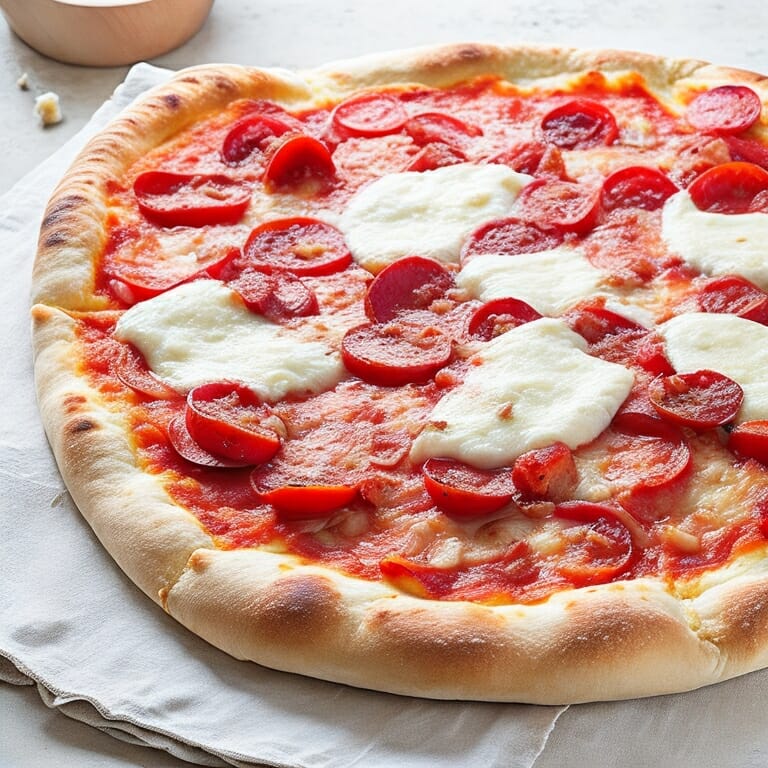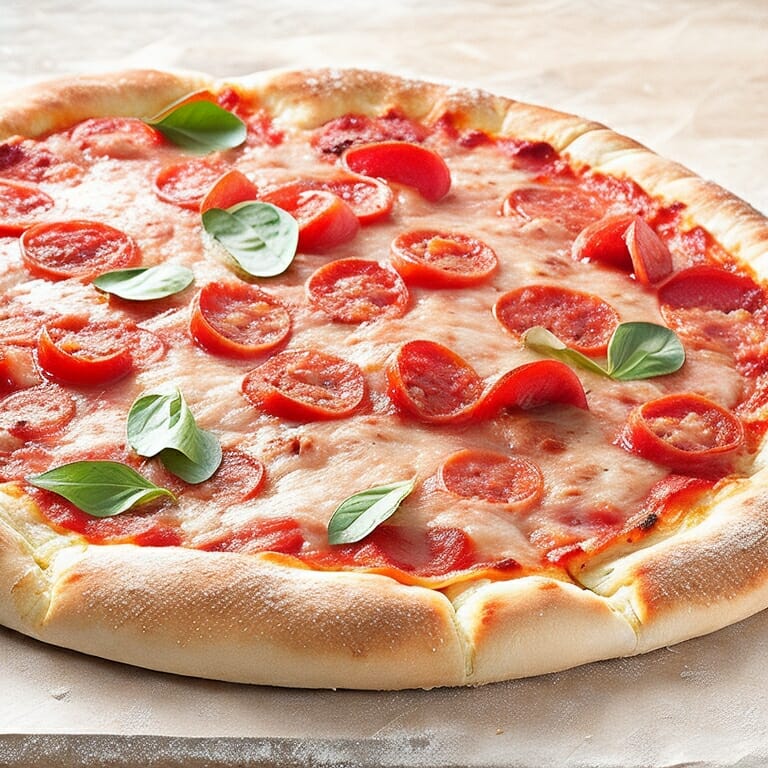Ingredients
A delicious homemade pizza needs the perfect pizza dough. To make it just right, you’ll require specific ingredients. This recipe will give all the components you need for a fluffy pizza dough that will wow any foodie. Let’s see what you need for this recipe!
You will need the following ingredients for this recipe:
- Flour
- Yeast
- Salt
- Sugar
- Olive Oil
- Warm Water

All-Purpose Flour
All-purpose flour is a must for making pizza dough. It contains hard and soft wheat, plus a range of gluten Strengths. Look for 11%-12% protein for the ideal texture. Bleached flours are best avoided; additives in them can change the taste.
When you’re making pizza at home, use 4-5 cups of all-purpose flour per batch.
Active Dry Yeast
Yeast is a must for pizza dough. Active dry yeast is the best choice. It is reliable and same in appearance and performance. The ideal temperature for proving active dry yeast is between 25-35 degrees Celsius. A free-standing oven or warm oven can be used as proving area.
To activate yeast, mix it with warm water and sugar or honey. This acts as food for the dormant organisms in granules of yeast. Leave it for 5-10 minutes. You should see small bubbles which mean the yeast has been activated. If no bubbles, discard and begin again with new active dry yeast or fresh compressed baking yeast.
Once activated, combine with other ingredients. Knead the pizza dough by hand or with stand mixer. Make sure everything is well incorporated. Then prove until doubled in size before forming and baking.
Salt
Salt is must for pizza dough. It adds flavor and makes the texture stronger. It also helps the dough to rise. Use sea salt or kosher salt for best results. Salt stops yeast from growing too much, which can weaken the pizza dough and stop it from rising.
It’s up to you how much salt you use, from half a teaspoon to one teaspoon. Don’t use too much salt as it might make your crust taste salty.
Water
Water is key for pizza dough. It links the proteins in flour plus helps create gluten. Finding the right balance of softness and elasticity is important.
Generally, using filtered, softened tap water is best. If the tap water isn’t great, bottled spring water works. Measure carefully, though. Too much or too little water changes the texture of the dough.

Directions
Create a unique pizza dough at home! It’s easy and yummy! Gather the required ingredients. Then, just follow these simple steps to have an amazing, fluffy pizza dough to wow your family or friends. Get started now!
- Step 1
- Step 2
- Step 3
- Step 4
Combine Flour, Yeast, and Salt
Mix 2 1/4 – 2 1/2 cups of all-purpose flour, 1 tsp of active dry yeast, and 3/4 tsp of kosher salt in a food processor. This is enough to make two pizzas, 10 inches each. Use bread flour if you want a crunchier crust. Pulse the mixture five times to mix the ingredients.
Start the processor and slowly add 1 cup plus 2 tablespoons of cold water through the feed tube. You may need up to 2 tablespoons more, depending on the climate and type of flour. This should take about one minute. When done, you should be able to form a clump that holds together when squeezed and does not fall apart.
Add Water
Once your dough is ready, add two cups of cold water to the bowl with the yeast. Stir gently with a wooden spoon until combined. If needed, add one tablespoon of water at a time. The dough should be sticky. When you pick up a handful, it should make a ball without cracking. If it’s too crumbly, add just enough water to make a ball.
Knead the Dough
Once your dough ball is ready, it’s kneading time! Sprinkle some flour onto a work surface and place the dough on top. Use the heels of your hands to press it lightly, and then fold one side over the other. Push on the edges with your hands, and rotate the dough a quarter-turn. Thoroughly repeat this for 5 minutes. You’ll end up with a smooth, springy ball of pizza dough that bounces back when tapped with a finger!
Put it in an oiled bowl. Cover the bowl with plastic wrap or a damp kitchen towel. Let it sit in a warm spot until it doubles in size, 1-2 hours.
Let the Dough Rise
Knead the dough and cover it with a damp cloth or lightly oiled plastic wrap. Put it in a warm place for 1-2 hours to rise. This helps develop flavor, color and makes the crust more tender. Experienced bakers often do a double rise. After one hour, punch down or push down the dough with your fist. Knead again and rise for an additional 45 minutes to 1 hour.
Divide the dough into two balls with your hands or an unfloured rolling pin. Place them on sprayed cookie sheets or a lightly oiled pizza pan. Pre-heat ovens to 425° F (220°C). Set oven rack at its lowest level. Partially cook shells that are crisp enough to hold their toppings. Add toppings just before baking.
Roll Out the Dough
On a lightly floured surface, roll out the pizza dough to the thickness and size you desire. Start in the center and press down with your fingertips or rolling pin as you work outward. You can use some oil on your hands to keep the dough from sticking. For a thin-crust pizza, roll it half an inch thick. If you prefer a thicker crust, roll it closer to one-inch. Avoid big thin patches when rolling out the crust for even cooking.
Transfer the dough onto parchment paper or a pre-greased cookie sheet or pizza stone. Dust off any extra flour beforehand, or you’ll end up with a soggy crust! Gently press down around the edges of the crust. Use a fork or your fingertips to form an edge around the outside of the crust for added crunch when baking.
Top the Pizza
Roll out your pizza dough and place it on a lightly greased baking sheet. (Try a pizza stone for extra-ambition!) Stretch the dough from the center outwards until it covers the pan.
Spread sauce first on the edges, then all over the pizza. Make sure it’s ¼-inch away from the edge. Toppings come next. Pile them up, but not too high or they can slip off. Place ingredients in an orderly fashion. Finally, sprinkle cheese lightly, so it coats the topping layer beneath. Don’t put too much cheese – it could cause flames during baking!
Bake the Pizza
Once your pizza dough is ready, it’s time to bake! Preheat your oven to 500 degrees Fahrenheit. Put the pizza stone or baking sheet in the oven to warm.
Sprinkle flour onto the work surface and stretch out the dough into a round shape that’s ⅓ inch thick. Use a rolling pin if needed. You can also create a raised crust by stretching the edge of the dough around the circumference of the round. Don’t prick any holes in the crust.
Lightly grease the baking stone/sheet and carefully slide on the pizza dough. Stretch it into place if needed. Top with desired ingredients:
- Spread a base layer of tomato sauce
- Add cheese, olives, and other toppings
Slide onto preheated baking stone/sheet. Bake 8-10 minutes. The crust should be golden brown, and the cheese melted. Serve hot or cold; enjoy!

Tips
Homemade pizzas are the way to go! You can choose the ingredients, make a healthier version and create your own flavour combos. But the most important part? The pizza dough! We’ve got the best recipe and some awesome tips. Let’s explore!
Use a Pizza Stone
To take your homemade pizza to the next level, try a pizza stone. It’s made from clay or cordierite and has an unglazed finish. It adds crunch and flavor, plus it helps the pizza bake evenly.
Instructions:
- Preheat the oven to 500°F (260°C).
- Place the dough on parchment paper on top of the pizza stone.
- Bake for 8-15 minutes, until golden brown.
- Take extra care when handling the hot pizza stone – it’ll be scorching hot!
Preheat the Oven
Preheat your oven before making a pizza. Generally, a thin crust or deep dish requires 400 degrees Fahrenheit (204 Celsius). Check the instructions on the pizza dough for accurate details. This also tells you how long to bake your pizza. Preheating helps achieve a crispier outside and softer inside.
Don’t put anything flammable (paper/plastic) in the oven, as it may be a fire hazard.
Use Room Temperature Water
For a light and airy pizza, use water at room temperature. Test it with a thermometer – it should be between 68‒76°F (20-24°C). If dough is still too dense, add more yeast or let it rise longer. That will help bring out flavors in the dough too!
Don’t go too cold or hot – it will make the pizza doughy.
Let the Dough Rise Slowly
Let your pizza dough rise in a warm spot. Knead it to develop gluten – a protein for bread doughs and other baking products. When you let it rise slowly, small bubbles form in the dough. This gives it flavour, aroma and better texture. It’s called ‘cold fermentation’ as it doesn’t touch heat. Room temperature works great. In hot weather, it’ll rise faster.
Store the dough in the fridge for 4-8 hours (depending on the temp). Take it out before rolling it out so it’s at room temperature (approx. 70°F).
Frequently Asked Questions
Q: What ingredients do I need to make the best pizza dough?
A: To make the best pizza dough you will need 3 1/2 cups of all-purpose flour, 1 teaspoon of salt, 1 teaspoon of white sugar, 1 package of active dry yeast, 1 1/2 cups of warm water, 2 tablespoons of extra-virgin olive oil.
Q: How do I knead the pizza dough?
A: To knead the pizza dough, first mix together the flour, salt and sugar in a large bowl. Then, add the yeast and water to the dry ingredients and stir with a wooden spoon until the mixture is combined. Once all of the ingredients are incorporated, knead the dough with your hands for about 8 minutes. Once kneaded, add the olive oil and knead for an additional 2 minutes.
Q: How long should I let the pizza dough rise?
A: Once you have finished kneading the pizza dough, place it in a greased bowl and cover with a damp cloth. Let the dough rise in a warm place for about 1 hour, or until the dough has doubled in size.

